使用 Visual Studio 把 ASP.NET Core Web 应用程序发布到Azure 云
作者 Rick Anderson 、 Cesar Blum Silveira
翻译 谢炀(Kiler)
安装开发环境
- 安装最新版版本的 Azure SDK for Visual Studio。如果你之前没有装过 Visual Studio,SDK 会安装 Visual Studio。
备注
如果你的机器之前任何依赖都没有安装过,SDK 的安装时间将会超过30分钟。
- 检查你的 Azure 账户. You can open a free Azure account or Activate Visual Studio subscriber benefits.
创建 Web 应用程序
In the Visual Studio Start Page, tap New Project....

Alternatively, you can use the menus to create a new project. Tap File > New > Project.... Alternatively, you can use the menus to create a new project. Tap File > New > Project....

Complete the New Project dialog: Complete the New Project dialog:
- In the left pane, tap Web
In the left pane, tap Web
In the center pane, tap ASP.NET Core Web Application (.NET Core)
In the center pane, tap ASP.NET Core Web Application (.NET Core)
Tap OK
- Tap OK

In the New ASP.NET Core Web Application (.NET Core) dialog: In the New ASP.NET Core Web Application (.NET Core) dialog:
- Tap Web Application
Tap Web Application
Verify Authentication is set to Individual User Accounts
Verify Authentication is set to Individual User Accounts
Verify Host in the cloud is not checked
Verify Host in the cloud is not checked
Tap OK
- Tap OK
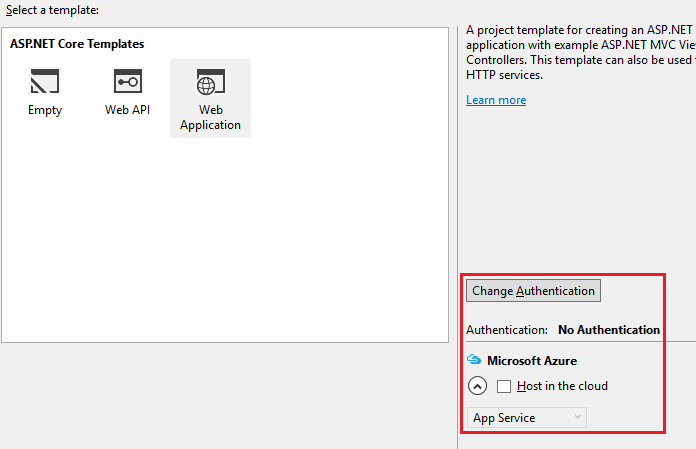
Test the app locally
Test the app locally
- Press Ctrl-F5 to run the app locally
Press Ctrl-F5 to run the app locally
Tap the About and Contact links. Depending on the size of your device, you might need to tap the navigation icon to show the links
- Tap the About and Contact links. Depending on the size of your device, you might need to tap the navigation icon to show the links

- Tap Register and register a new user. You can use a fictitious email address. When you submit, you'll get the following error:
- Tap Register and register a new user. You can use a fictitious email address. When you submit, you'll get the following error:

You can fix the problem in two different ways: You can fix the problem in two different ways:
- Tap Apply Migrations and, once the page updates, refresh the page; or
Tap Apply Migrations and, once the page updates, refresh the page; or
Run the following from a command prompt in the project's directory:
Run the following from a command prompt in the project's directory:
dotnet ef database update
The app displays the email used to register the new user and a Log off link. The app displays the email used to register the new user and a Log off link.
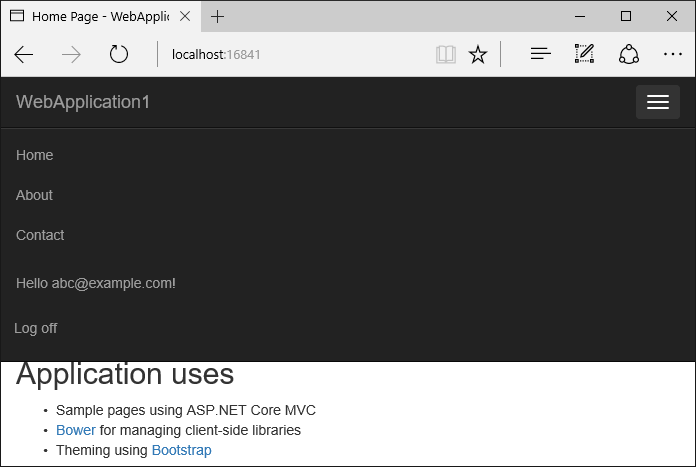
Deploy the app to Azure
Deploy the app to Azure
Right-click on the project in Solution Explorer and select Publish.... Right-click on the project in Solution Explorer and select Publish....

In the Publish dialog, tap Microsoft Azure App Service. In the Publish dialog, tap Microsoft Azure App Service.

Tap New... to create a new resource group. Creating a new resource group will make it easier to delete all the Azure resources you create in this tutorial. Tap New... to create a new resource group. Creating a new resource group will make it easier to delete all the Azure resources you create in this tutorial.

Create a new resource group and app service plan: Create a new resource group and app service plan:
- Tap New... for the resource group and enter a name for the new resource group
Tap New... for the resource group and enter a name for the new resource group
Tap New... for the app service plan and select a location near you. You can keep the default generated name
Tap New... for the app service plan and select a location near you. You can keep the default generated name
Tap Explore additional Azure services to create a new database
- Tap Explore additional Azure services to create a new database

- Tap the green + icon to create a new SQL Database
- Tap the green + icon to create a new SQL Database

- Tap New... on the Configure SQL Database dialog to create a new database server.
- Tap New... on the Configure SQL Database dialog to create a new database server.

- Enter an administrator user name and password, and then tap OK. Don't forget the user name and password you create in this step. You can keep the default Server Name
- Enter an administrator user name and password, and then tap OK. Don't forget the user name and password you create in this step. You can keep the default Server Name

备注
"admin" is not allowed as the administrator user name.
备注
"admin" is not allowed as the administrator user name.
- Tap OK on the Configure SQL Database dialog
- Tap OK on the Configure SQL Database dialog

- Tap Create on the Create App Service dialog
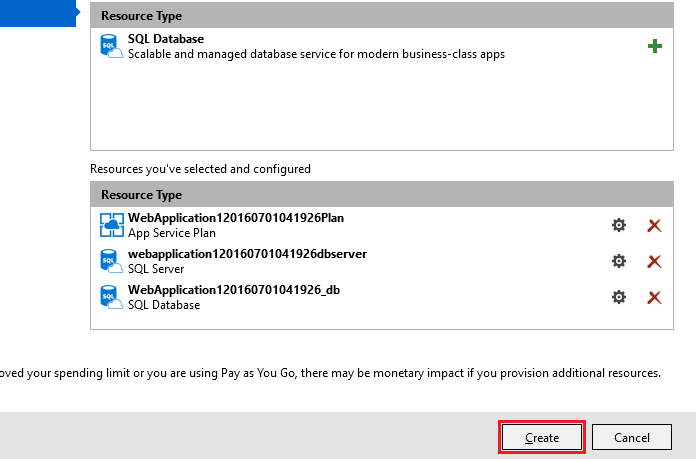
- Tap Next in the Publish dialog

On the Settings stage of the Publish dialog:
Expand Databases and check Use this connection string at runtime
Expand Entity Framework Migrations and check Apply this migration on publish
Tap Publish and wait until Visual Studio finishes publishing your app
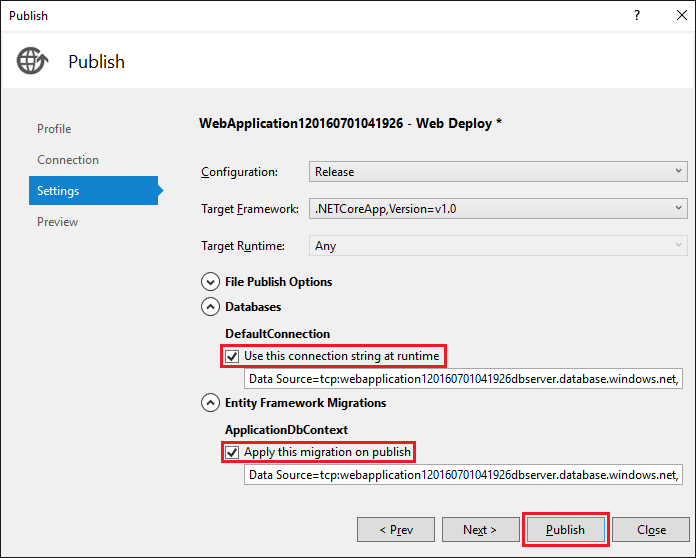
Visual Studio will publish your app to Azure and launch the cloud app in your browser.
Test your app in Azure
Test the About and Contact links
Register a new user

Update the app
- Edit the
Views/Home/About.cshtmlRazor view file and change its contents. For example:
@{
ViewData["Title"] = "About";
}
<h2>@ViewData["Title"].</h2>
<h3>@ViewData["Message"]</h3>
<p>My updated about page.</p>
- Right-click on the project and tap Publish... again

- After the app is published, verify the changes you made are available on Azure
Clean up
When you have finished testing the app, go to the Azure portal and delete the app.
- Select Resource groups, then tap the resource group you created

- In the Resource group blade, tap Delete
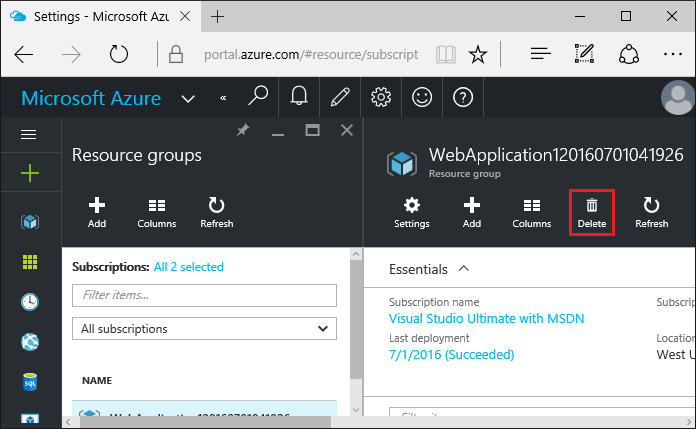
- Enter the name of the resource group and tap Delete. Your app and all other resources created in this tutorial are now deleted from Azure